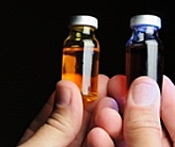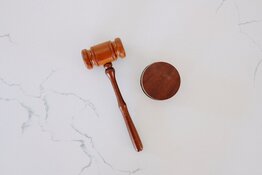
Shaking up the color wheel, the FDA released what it's calling the Purple Book—a listing of biologics that may serve as reference products for biosimilars and interchangeables.
Actually, the Purple Book is two listings. One references 104 biologics approved by the FDA's drug center, and the other lists 276 biologic products, including vaccines, approved by the biologics center. The lists will be updated periodically as new biologics and follow-ons are approved.
Each listing includes the biologic license application (BLA) number, nonproprietary product name, brand name, date of licensure, date of first licensure and expiration date of reference drug and pediatric exclusivity. (Since orphan drug exclusivity is available elsewhere, the FDA said it would not be included in the listing.) The Purple Book also indicates whether a product has been withdrawn.
In the future, the listings will grow to include approved biosimilars and interchangeables for each reference biologic. When follow-ons are added under the reference product, the listing will show whether they are considered a biosimilar or an interchangeable.
The Purple Book is being welcomed by industry. "As a manufacturer of both innovative and biosimilar medicines, Amgen supports FDA's move to make information on biologic product approvals easily available," Kelley Davenport, director of global communications for Amgen Inc., told BioWorld Today.
She expects the Purple Book will evolve as the number of approved products increase and patient, prescriber and manufacturer needs change over time.
The biologics listings are based on the Orange Book the FDA maintains for small-molecule drugs. And like the Orange Book in its earliest incarnation, the Purple Book will serve as a tool for state health agencies, prescribers and pharmacists in determining which follow-ons can automatically be substituted or serve as an alternative for a specific reference biologic.
First published in 1980 in response to requests from state agencies that govern pharmacy practices, the Orange Book was designed to help those agencies, as well as prescribers and pharmacists, promote public education about generics and contain health care costs, the FDA said in the preface to the book.
Four years later, the Orange Book was written into law when the FDA was required to release a regular addendum identifying small-molecule drugs that qualify under the 1984 Hatch-Waxman Act for periods of exclusivity. Under the act, the listing had to include patent information that could delay the approval of a generic or 505(b)(2) drug.
That information made the Orange Book a valuable resource for drugmakers developing a pipeline of generic drugs for the U.S. market.
No Patents in Purple
Unlike the Orange Book, the Purple Book includes no patent information, in keeping with the 2010 Biologic Price Competition and Innovation Act (BPCIA), which authorized the FDA to establish a path for biosimilars and interchangeables.
Given the many patent claims on each biologic, Congress intentionally removed the FDA from the patent fray. Instead, it set up an intricate exchange of patent information between the maker of the reference product and the biosimilar/interchangeable sponsor. (See BioWorld Today, June 29, 2011.)
As the law is written, the exchange is to begin after the FDA approves a follow-on.
That timing could delay the launch of biosimilars and interchangeables, especially if drugmakers have to rigidly adhere to what could be a 200-day exchange before they can resort to litigation.
Two companies—Sandoz Inc. and Celltrion Inc.—have tried to bypass the exchange by filing patent challenges similar to what is seen with generic drugs.
Calling it premature, Maxine Chesney, a federal judge in California, denied Sandoz's request for declaratory judgment that the Enbrel (etanercept) biosimilar it's developing doesn't infringe two patents owned by Roche AG and exclusively licensed to Amgen Inc. (See BioWorld Today, Nov. 15, 2013.)
Before parties can take a biosimilar patent challenge to court, they must first follow the steps of the information exchange Congress laid out in the BPCIA, the judge ruled last year. Those steps begin after the FDA approves the biosimilar, she reaffirmed.
Looking for a second opinion, Celltrion filed suit in March in a federal court in Massachusetts seeking declaratory judgment that Janssen Biotech Inc.'s remaining patents on the reference drug Remicade (infliximab) are invalid and unenforceable. (See BioWorld Today, April 3, 2014.)
With Janssen claiming patent protection into 2018, the two drugmakers are on an "inevitable collision course" and relief is needed sooner rather than later, Celltrion said in its complaint. The South Korean drugmaker submitted a BLA for its infliximab biosimilar in August, clearing the way for an FDA decision in June 2015. (See BioWorld Today, Aug. 12, 2014.)
Meanwhile, the court has yet to rule on Celltrion's suit.
Mari Serebrov
BioWorld



































